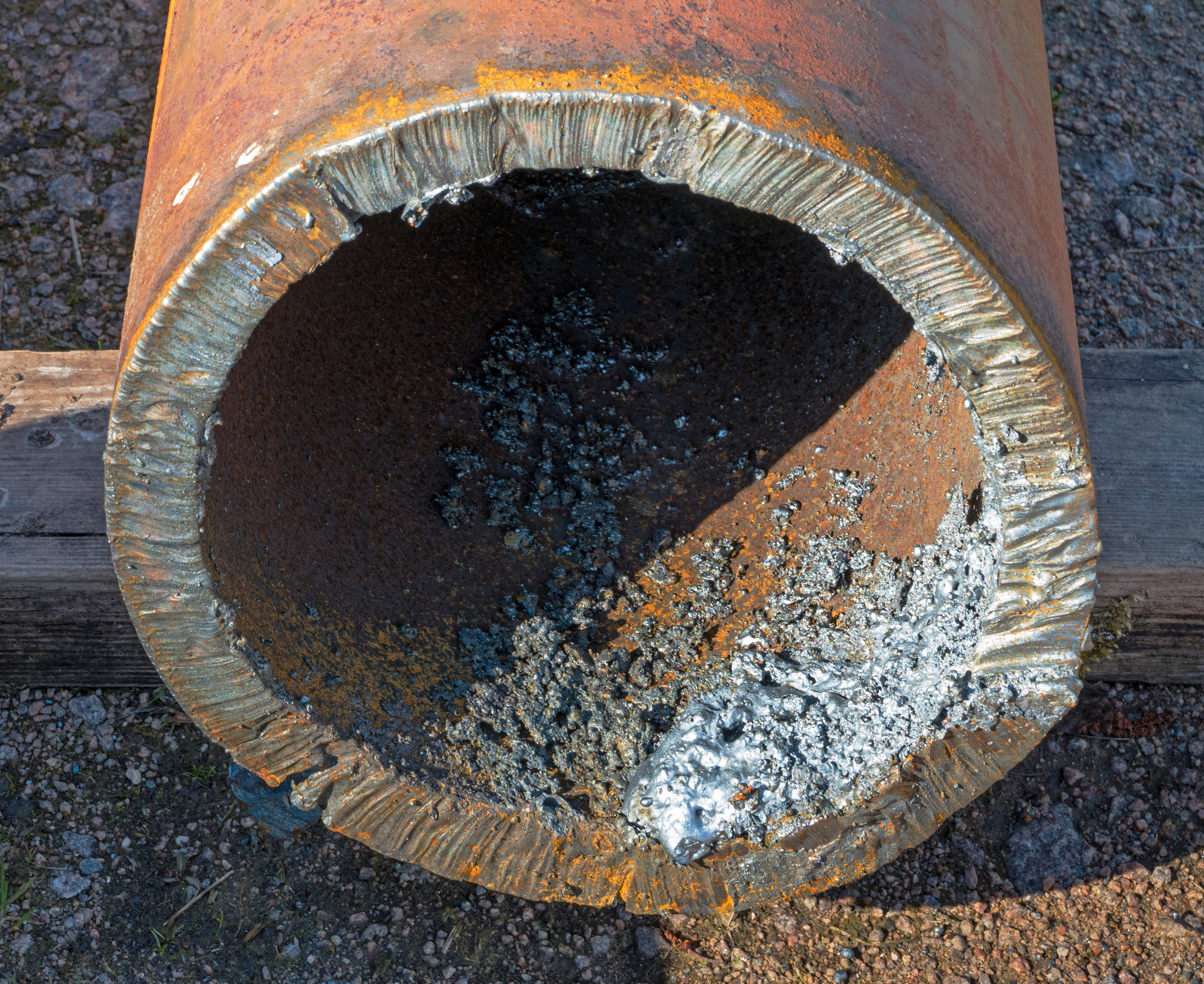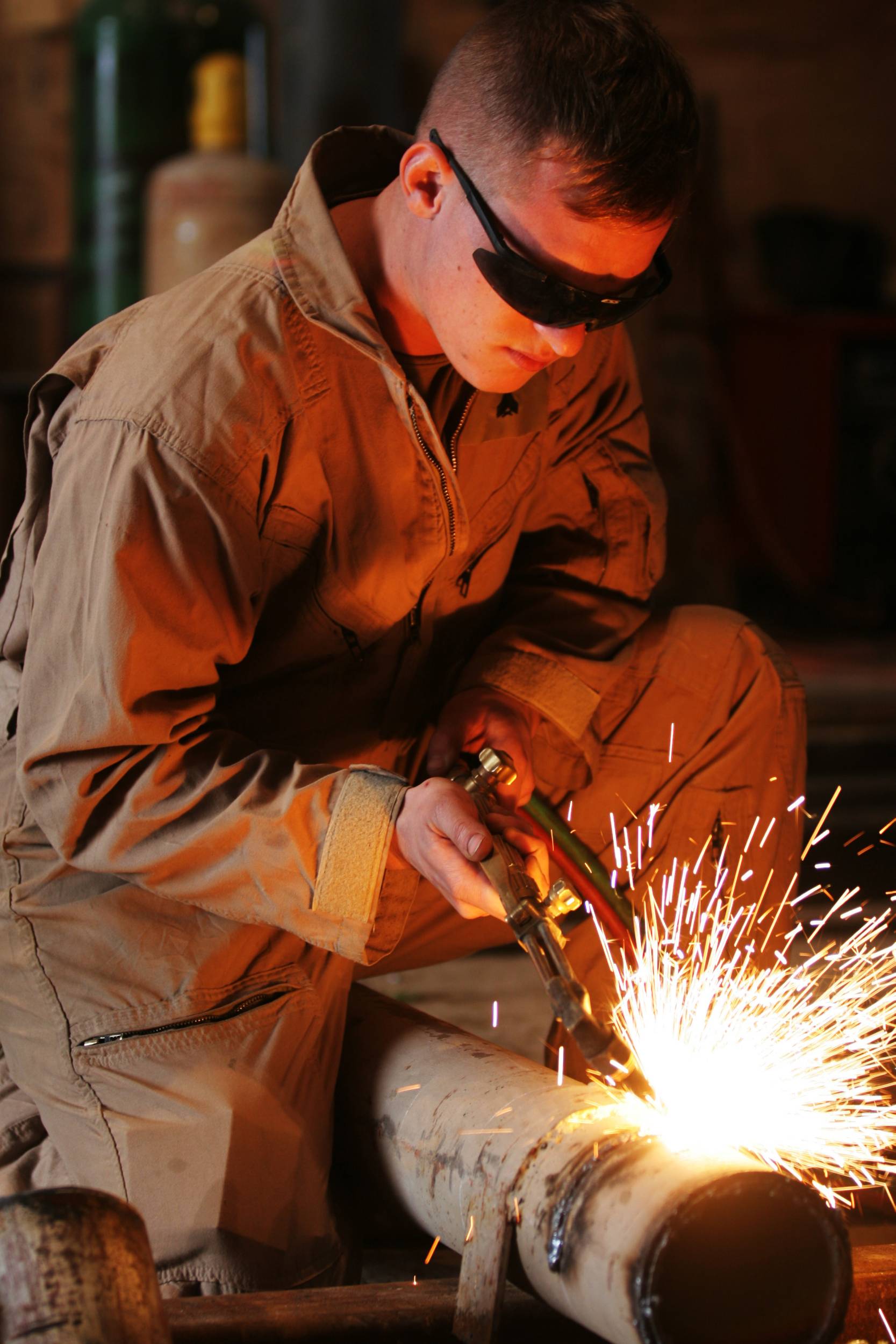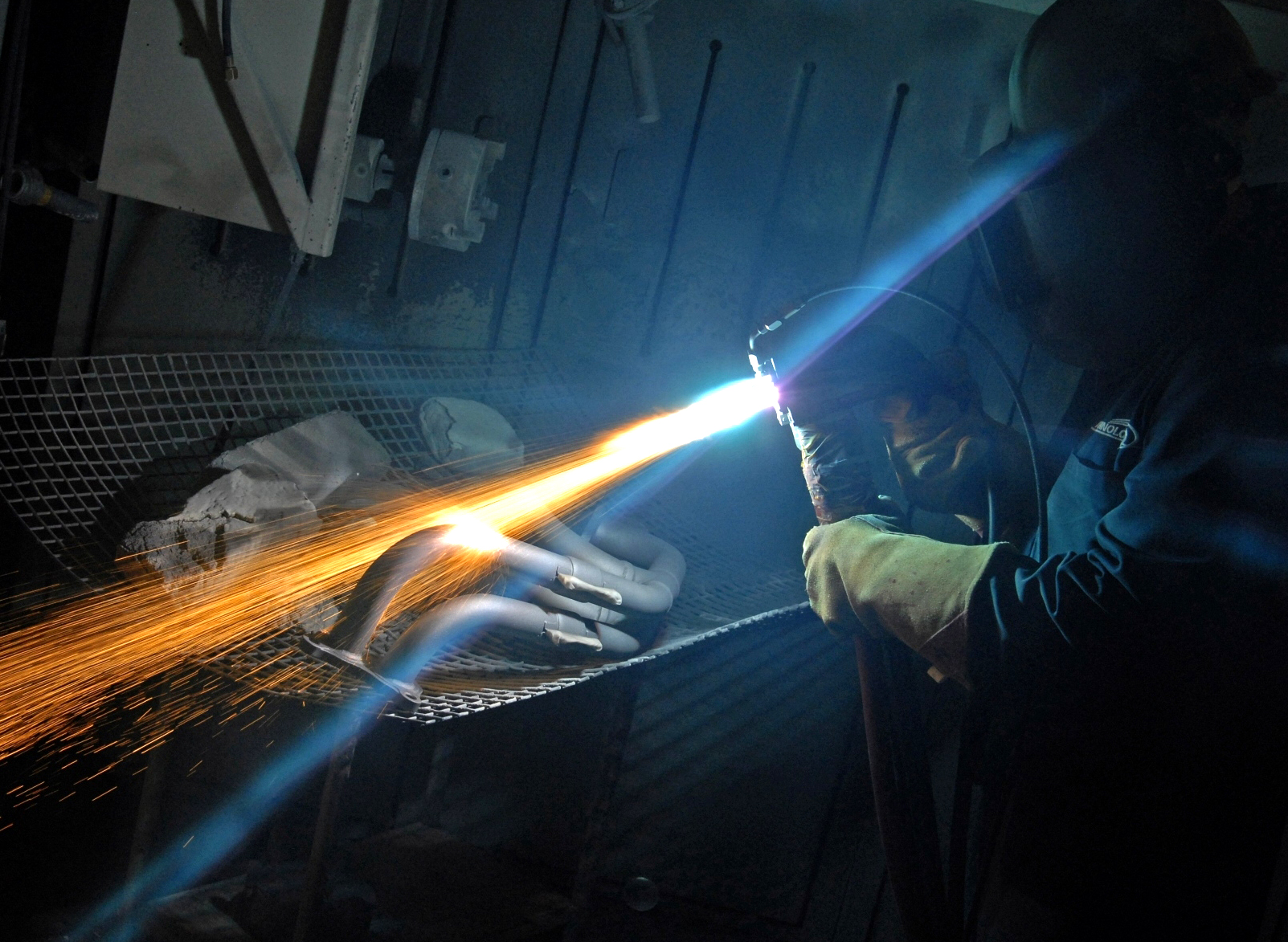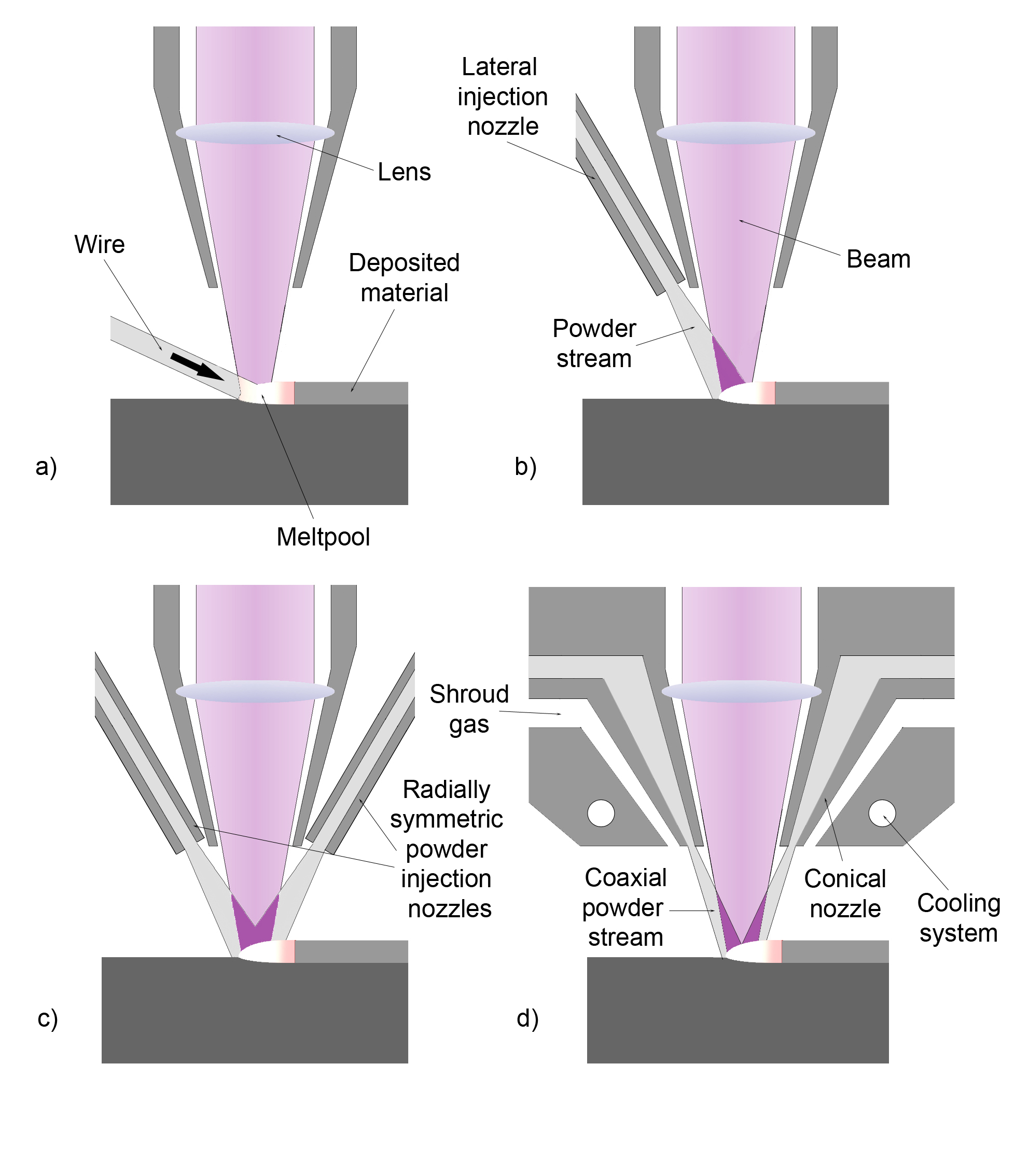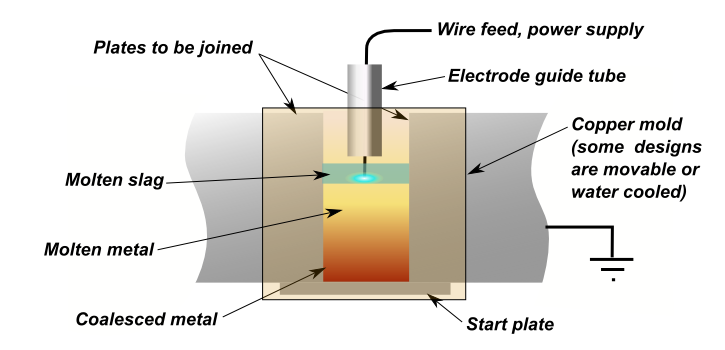|
Hardfacing
Hardfacing is a metalworking process where harder or tougher material is applied to a base metal. It is welded to the base material, and generally takes the form of specialized electrodes for arc welding or filler rod for oxyacetylene and gas tungsten arc welding. Powder metal alloys are used in plasma-transferred arc (PTA), also called powder plasma welding, and thermal spray processes like high-velocity oxygen fuel coating, plasma spray, spray and fuse, etc. Submerged arc welding, flux core arc welding (FCAW) and metal inert gas (MIG) / metal active gas (MAG) use continuously fed wire varying in diameter depending on the process and current. The strip cladding process uses strips from 50 mm wide to 125 mm with a thickness of 0.5mm. Open arc welding uses a continuously fed tubular electrode which may or may not contain flux. Hardfacing may be applied to a new part during production to increase its wear resistance, or it may be used to restore a worn-down surface. Hardfac ... [...More Info...] [...Related Items...] OR: [Wikipedia] [Google] [Baidu] |
Oxy-fuel Welding And Cutting
Principle of burn cutting Oxy-fuel welding (commonly called oxyacetylene welding, oxy welding, or gas welding in the United States) and oxy-fuel cutting are processes that use fuel gases (or liquid fuels such as gasoline or petrol, diesel, biodiesel, kerosene, etc) and oxygen to weld or cut metals. French engineers Edmond Fouché and Charles Picard became the first to develop oxygen-acetylene welding in 1903. Pure oxygen, instead of air, is used to increase the flame temperature to allow localized melting of the workpiece material (e.g. steel) in a room environment. A common propane/air flame burns at about , a propane/oxygen flame burns at about , an oxyhydrogen flame burns at and an acetylene/oxygen flame burns at about . During the early 20th century, before the development and availability of coated arc welding electrodes in the late 1920s that were capable of making sound welds in steel, oxy-acetylene welding was the only process capable of making welds of exceptiona ... [...More Info...] [...Related Items...] OR: [Wikipedia] [Google] [Baidu] |
Stellite
Stellite alloys are a range of cobalt-chromium alloys designed for wear resistance. "Stellite" is also a registered trademark of Kennametal Inc. and is used in association with cobalt-chromium alloys. History Stellite was invented by Elwood Haynes in the early 1900s, initially as a material for making cutlery that would not stain or require constant cleaning. He was granted a patent for two specific alloys in 1907, and for two related ones in 1912; once he had these four patents he went into the business of producing his metal alloys. In the early 1920s, after considerable success during World War I in sales of cutting tools and high-speed machine tools made from Stellite, Haynes's company was bought by Union Carbide, becoming its "Stellite division", and continued to develop other alloys as well. The company was sold again in 1970 to Cabot Corporation, and in 1985 Cabot sold off the Stellite portion of the business. The Stellite trademark was acquired by Kennametal in 2012. Co ... [...More Info...] [...Related Items...] OR: [Wikipedia] [Google] [Baidu] |
Oxyfuel Welding
Principle of burn cutting Oxy-fuel welding (commonly called oxyacetylene welding, oxy welding, or gas welding in the United States) and oxy-fuel cutting are processes that use fuel gases (or liquid fuels such as gasoline or petrol, diesel, biodiesel, kerosene, etc) and oxygen to weld or cut metals. French engineers Edmond Fouché and Charles Picard became the first to develop oxygen-acetylene welding in 1903. Pure oxygen, instead of air, is used to increase the flame temperature to allow localized melting of the workpiece material (e.g. steel) in a room environment. A common propane/air flame burns at about , a propane/oxygen flame burns at about , an oxyhydrogen flame burns at and an acetylene/oxygen flame burns at about . During the early 20th century, before the development and availability of coated arc welding electrodes in the late 1920s that were capable of making sound welds in steel, oxy-acetylene welding was the only process capable of making welds of exceptional ... [...More Info...] [...Related Items...] OR: [Wikipedia] [Google] [Baidu] |
Thermal Spraying
Thermal spraying techniques are coating processes in which melted (or heated) materials are sprayed onto a surface. The "feedstock" (coating precursor) is heated by electrical (plasma or arc) or chemical means (combustion flame). Thermal spraying can provide thick coatings (approx. thickness range is 20 microns to several mm, depending on the process and feedstock), over a large area at high deposition rate as compared to other coating processes such as electroplating, physical vapor deposition, physical and chemical vapor deposition. Coating materials available for thermal spraying include metals, alloys, ceramics, plastics and composites. They are fed in powder or wire form, heated to a molten or semimolten state and accelerated towards substrates in the form of micrometer-size particles. Combustion or electrical arc discharge is usually used as the source of energy for thermal spraying. Resulting coatings are made by the accumulation of numerous sprayed particles. The surface ... [...More Info...] [...Related Items...] OR: [Wikipedia] [Google] [Baidu] |
Plasma Arc Welding
Plasma arc welding (PAW) is an arc welding process similar to gas tungsten arc welding (GTAW). The electric arc is formed between an electrode (which is usually but not always made of sintered tungsten) and the workpiece. The key difference from GTAW is that in PAW, the electrode is positioned within the body of the torch, so the plasma arc is separated from the shielding gas envelope. The plasma is then forced through a fine-bore copper nozzle which constricts the arc and the plasma exits the orifice at high velocities (approaching the speed of sound) and a temperature approaching 28,000 °C (50,000 °F) or higher. Arc plasma is a temporary state of a gas. The gas gets ionized by electric current passing through it and it becomes a conductor of electricity. In ionized state, atoms are broken into electrons (−) and cations (+) and the system contains a mixture of ions, electrons and highly excited atoms. The degree of ionization may be between 1% and greater tha ... [...More Info...] [...Related Items...] OR: [Wikipedia] [Google] [Baidu] |
Welding
Welding is a fabrication (metal), fabrication process that joins materials, usually metals or thermoplastics, primarily by using high temperature to melting, melt the parts together and allow them to cool, causing Fusion welding, fusion. Common alternative methods include solvent welding (of thermoplastics) using chemicals to melt materials being bonded without heat, and #Solid-state welding, solid-state welding processes which bond without melting, such as pressure, cold welding, and diffusion bonding. Metal welding is distinct from lower temperature bonding techniques such as brazing and soldering, which do not melt the base metal (parent metal) and instead require flowing a filler metal to solidify their bonds. In addition to melting the base metal in welding, a filler material is typically added to the joint to form a pool of molten material (the weld pool) that cools to form a joint that can be stronger than the base material. Welding also requires a form of shield to ... [...More Info...] [...Related Items...] OR: [Wikipedia] [Google] [Baidu] |
Welding Procedure
A Welding Procedure Specification (WPS) is a formal document describing welding procedures. It is an internal document used by welding companies to instruct welders (or welding operators) on how to achieve quality production welds that meet all relevant code requirements. Each company typically develops their own WPS for each material alloy and for each welding type used. Specific codes and/or engineering societies are often the driving force behind the development of a company's WPS. A WPS is supported by a Procedure Qualification Record (PQR or WPQR), a formal record of a test weld performed and rigorously tested to ensure that the procedure will produce a good weld. Individual welders are certified with a qualification test documented in a Welder Qualification Test Record (WQTR) that shows they have the understanding and demonstrated ability to work within the specified WPS. Introduction The following are definitions for WPS and PQR found in various codes and standards: Accor ... [...More Info...] [...Related Items...] OR: [Wikipedia] [Google] [Baidu] |
NOREM
Earl H. Norem (April 17, 1923 – June 19, 2015), who signed his work simply Norem, was an American artist primarily known for his painted covers for men's-adventure magazines published by Martin Goodman's Magazine Management Company and for Goodman's line of black-and-white comics magazines affiliated with his Marvel Comics division. Over his long career, Norem also illustrated covers for novels and gaming books, as well as movie posters, baseball programs, and trading cards. Early life Norem was born on April 17, 1923. He saw military action in World War II with the 85th Regiment of the 10th Mountain Division. He trained in Colorado and Texas, and fought the Germans in the Northern Apennine Mountains of Italy. By age 20, Norem was a squad leader and staff sergeant who in the Italian Campaign fought alongside famed skier Torger Tokle, whom he had seen ski jumping at Bear Mountain, New York, when Norem was 12. After Tokle was killed in action on March 3, 1945, Norem was one o ... [...More Info...] [...Related Items...] OR: [Wikipedia] [Google] [Baidu] |
Chromium Carbide
Chromium(II) carbide is a ceramic compound that exists in several chemical compositions: Cr3C2, Cr7C3, and Cr23C6. At standard conditions it exists as a gray solid. It is extremely hard and corrosion resistant. It is also a refractory compound, which means that it retains its strength at high temperatures as well. These properties make it useful as an additive to metal alloys. When chromium carbide crystals are integrated into the surface of a metal it improves the wear resistance and corrosion resistance of the metal, and maintains these properties at elevated temperatures. The hardest and most commonly used composition for this purpose is Cr3C2. The mineral form of the Cr3C2 compound is tongbaite. Isovite, , is a related mineral. Both are extremely rare. Yet another chromium-rich carbide mineral is yarlongite, Cr4Fe4NiC4.Mindat, http://www.mindat.org/min-35899.html Properties There are three different crystal structures for chromium carbide corresponding to the three diff ... [...More Info...] [...Related Items...] OR: [Wikipedia] [Google] [Baidu] |
Cladding (metalworking)
Cladding is the bonding together of dissimilar metals. It is different from fusion welding or adhesive, gluing as a method to fasten the metals together. Cladding is often achieved by extrude, extruding two metals through a die (manufacturing), die as well as machine press, pressing or cold rolling, rolling sheets together under high pressure. The United States Mint uses cladding to manufacture coins from different metals. This allows a cheaper metal to be used as a filler. For example, dimes and quarters struck since 1965 have cores made from pure copper, with a clad layer consisting of 75% copper and 25% nickel added during production. Half dollars struck from 1965 to 1969 for circulation and in 1970 for collectors also incorporated cladding, albeit in the case of those coins, the core was a mixture of 20.9% silver and 79.1% copper, and its clad layer was 80% silver and 20% copper. Half dollars struck since 1971 are produced identically to the dimes and quarters. Laser cladding ... [...More Info...] [...Related Items...] OR: [Wikipedia] [Google] [Baidu] |
Electroslag Welding
Electroslag welding (ESW) is a highly productive, single pass welding process for thick (greater than 25 mm up to about 300 mm) materials in a vertical or close to vertical position. (ESW) is similar to electrogas welding, but the main difference is the arc starts in a different location. An electric arc is initially struck by wire that is fed into the desired weld location and then flux is added. Additional flux is added until the molten slag, reaching the tip of the electrode, extinguishes the arc. The wire is then continuously fed through a consumable guide tube (can oscillate if desired) into the surfaces of the metal workpieces and the filler metal are then melted using the electrical resistance of the molten slag to cause coalescence. The wire and tube then move up along the workpiece while a copper retaining shoe that was put into place before starting (can be water-cooled if desired) is used to keep the weld between the plates that are being welded. Electroslag w ... [...More Info...] [...Related Items...] OR: [Wikipedia] [Google] [Baidu] |
